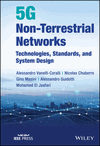Non-Terrestrial Networks Overview
Summary
Satellite Communications encompass the use of an artificial satellite to establish communication with different locations on or close to the Earth's surface. Thus, a Satellite Communications system, or Non-Terrestrial Network (NTN), can be defined as a telecommunications system, including a communication satellite in its end-to-end link. This chapter provides an introduction to the main characteristics of NTNs in terms of orbits, along with their advantages and disadvantages, constellations and constellation design principles, space mission geometry, and link budget computation. The basic principles of orbital motion are discussed, including the concept of Keplerian orbits, orbital parameters, and orbital perturbations; these will be exploited to define the different types of orbits, in particular those of interest for NTN, and a few concepts related to the design of NTN constellations. The chapter exploits space mission geometry to characterize Doppler and propagation delays and to define the individual and overall link budgets.



